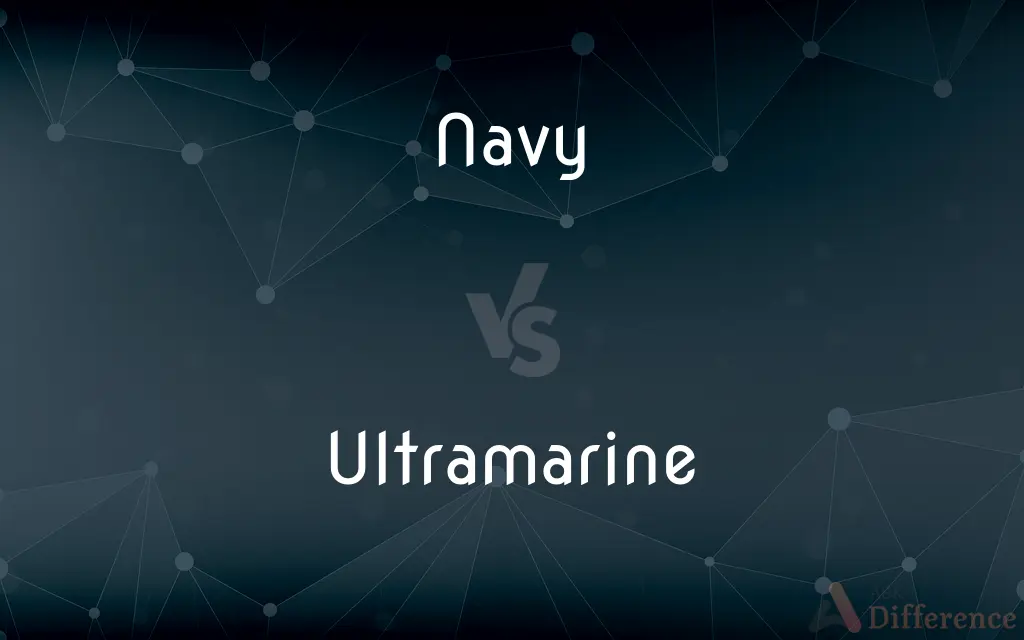Navy vs. Ultramarine — What's the Difference?
Edited by Tayyaba Rehman — By Fiza Rafique — Updated on September 20, 2023
Navy is a dark blue shade resembling marine uniforms, while ultramarine is a vivid blue pigment originally made from lapis lazuli.

Difference Between Navy and Ultramarine
Table of Contents
ADVERTISEMENT
Key Differences
Both navy and ultramarine are terms associated with the blue color spectrum. Navy refers to a deep, almost blackish-blue hue often linked to marine uniforms. In contrast, ultramarine is a bright and vibrant blue pigment originally sourced from the semi-precious stone, lapis lazuli.
When considering their origin, navy's association with the color blue stems from the uniforms of the naval officers, which are typically of this dark blue hue. Ultramarine's roots are more historical and artistic, as this pigment was once a luxury item used in Renaissance paintings.
From a color palette perspective, navy serves as a neutral, versatile color often utilized in formal wear and business attire. Ultramarine, on the other hand, stands out as a more brilliant blue, often reserved for art and decorative pieces to capture attention.
Both navy and ultramarine have seen their usage expand beyond just color descriptions. While navy can refer to a nation's naval forces, ultramarine has been a term that represents a standard of quality, given its historical value and rarity.
Today, in the realm of digital art and design, both navy and ultramarine have specific color codes that allow designers to reproduce them accurately on screens. Though their origins are diverse, their impact on visual culture is undeniable.
ADVERTISEMENT
Comparison Chart
Origin of Name
Naval uniforms
Lapis lazuli stone
Hue Depth
Darker blue
Bright, vivid blue
Common Uses
Uniforms, formal wear, design
Art, paint, decorative items
Extended Meanings
Can refer to a nation's naval forces
Represents a standard of quality
Relation to Color Spectrum
Closer to blackish-blue
Closer to pure, vibrant blue
Compare with Definitions
Navy
The branch of a nation's armed forces conducted at sea.
He served in the navy for twenty years.
Ultramarine
A color resembling the deep blue of clear seas.
The room was painted in an ultramarine shade.
Navy
A collective term for a nation's warships and naval personnel.
The navy defended the coastlines during the war.
Ultramarine
An adjective describing a brilliant blue color.
The sky was an ultramarine canvas at sunset.
Navy
Pertaining to or connected with a navy.
He attended the navy parade in the capital.
Ultramarine
A bright blue pigment made from ground lapis lazuli.
Renaissance painters valued ultramarine for its vivid hue.
Navy
A dark blue shade resembling marine uniforms.
She wore a navy dress to the formal event.
Ultramarine
Pertaining to the superior quality of blue pigments.
The artist chose ultramarine for the masterpiece.
Navy
A navy, naval force, or maritime force is the branch of a nation's armed forces principally designated for naval and amphibious warfare; namely, lake-borne, riverine, littoral, or ocean-borne combat operations and related functions. It includes anything conducted by surface ships, amphibious ships, submarines, and seaborne aviation, as well as ancillary support, communications, training, and other fields.
Ultramarine
Ultramarine is a deep blue color pigment which was originally made by grinding lapis lazuli into a powder. The name comes from the Latin ultramarinus, literally "beyond the sea", because the pigment was imported into Europe from mines in Afghanistan by Italian traders during the 14th and 15th centuries.Ultramarine was the finest and most expensive blue used by Renaissance painters.
Navy
All of a nation's warships.
Ultramarine
A brilliant deep blue pigment originally obtained from lapis lazuli, now made from powdered fired clay, sodium carbonate, sulphur, and resin
Ultramarine blue
Navy
Often Navy A nation's entire military organization for sea warfare and defense, including vessels, personnel, and shore establishments.
Ultramarine
A blue pigment made from powdered lapis lazuli.
Navy
A group of ships; a fleet.
Ultramarine
A similar pigment made synthetically by heating clay, sodium carbonate, and sulfur together.
Navy
Navy blue.
Ultramarine
A vivid or strong blue to purplish blue.
Navy
(countable) A country's entire sea force, including ships and personnel.
People who get seasick easily shouldn't join the navy.
Ultramarine
Of the color ultramarine.
Navy
(countable) A governmental department in charge of a country's sea force.
Ultramarine
Of or from a place beyond the sea.
Navy
A dark blue colour, usually called navy blue.
Ultramarine
(archaic) Beyond the sea.
Navy
(color) Having the dark blue colour of navy blue.
Ultramarine
Of a brilliant dark blue or slightly purplish colour like that of the pigment (noun sense 1).
Navy
(military) Belonging to the navy; typical of the navy.
Ultramarine
In full ultramarine blue: a brilliant blue pigment that was traditionally made from ground-up lapis lazuli, and now usually either extracted from mineral deposits or made synthetically.
Navy
A fleet of ships; an assemblage of merchantmen, or so many as sail in company.
Ultramarine
A brilliant dark blue or slightly purplish colour like that of the pigment.
Navy
The whole of the war vessels belonging to a nation or ruler, considered collectively; as, the navy of Italy.
Ultramarine
Situated or being beyond the sea.
Navy
The officers and men attached to the war vessels of a nation; as, he belongs to the navy.
Ultramarine
A blue pigment formerly obtained by powdering lapis lazuli, but now produced in large quantities by fusing together silica, alumina, soda, and sulphur, thus forming a glass, colored blue by the sodium polysulphides made in the fusion. Also used adjectively.
Navy
Same as navy blue.
Ultramarine
Blue pigment made of powdered lapis lazuli
Navy
Having a color of navy blue.
Ultramarine
Vivid blue to purple-blue
Navy
An organization of military naval forces
Ultramarine
Of a brilliant pure blue to purplish blue color
Navy
A dark shade of blue
Ultramarine
A reference to something located beyond the seas.
He traveled to ultramarine territories for trade.
Navy
A color often linked with formality and elegance.
The wedding theme was gold and navy.
Common Curiosities
Can navy also refer to a group of ships?
Yes, navy can mean a nation's collective warships and naval personnel.
What's the primary distinction between navy and ultramarine?
Navy is a dark blue hue, while ultramarine is a bright blue pigment.
Why was ultramarine historically significant in art?
Ultramarine was a luxury pigment, highly prized in Renaissance art.
Are navy uniforms universally dark blue?
Most naval uniforms are navy-colored, but designs and shades can vary by country.
What's the origin of ultramarine's color?
Ultramarine was originally made from the ground lapis lazuli stone.
Is navy associated with maritime forces?
Yes, navy often refers to a nation's naval forces or their uniforms.
Are there variations within the navy color?
Yes, like all colors, navy can have variations in shade and depth.
Does navy always mean a dark shade of blue?
While navy predominantly refers to a dark blue, its shade can vary based on context.
Was ultramarine always an accessible pigment?
No, ultramarine was once rare and expensive, sourced from lapis lazuli.
Which color is closer to black, navy or ultramarine?
Navy is closer to black, being a deep blue hue.
Is ultramarine always brighter than navy?
Typically, ultramarine is a more vivid blue compared to the darker navy.
Is navy blue considered neutral in fashion?
Yes, navy blue is often seen as a versatile and neutral color in fashion.
Is ultramarine used in modern day art?
Yes, ultramarine is still a popular choice in paints and art mediums today.
Can ultramarine be synthetically produced?
Yes, today there are synthetic alternatives to natural ultramarine.
Do any cultures have specific significance attached to ultramarine?
Ultramarine's significance often ties to art and religion due to its historical value.
Share Your Discovery

Previous Comparison
Similar vs. Simular
Next Comparison
Demonstration vs. IllustrationAuthor Spotlight
Written by
Fiza RafiqueFiza Rafique is a skilled content writer at AskDifference.com, where she meticulously refines and enhances written pieces. Drawing from her vast editorial expertise, Fiza ensures clarity, accuracy, and precision in every article. Passionate about language, she continually seeks to elevate the quality of content for readers worldwide.
Edited by
Tayyaba RehmanTayyaba Rehman is a distinguished writer, currently serving as a primary contributor to askdifference.com. As a researcher in semantics and etymology, Tayyaba's passion for the complexity of languages and their distinctions has found a perfect home on the platform. Tayyaba delves into the intricacies of language, distinguishing between commonly confused words and phrases, thereby providing clarity for readers worldwide.
















































